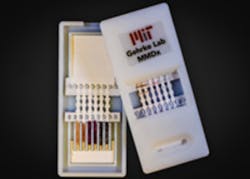Future Watch
Pocket-size 10-minute Ebola test created
Researchers at the Massachusetts Institute of Technolgy (MIT) have developed a paper diagnostic device that can detect multiple diseases, including Ebola and other viral hemorrhagic fevers, in about 10 minutes. The device has silver nanoparticles of different colors that indicate different diseases (the unit pictured has been used for diagnosis; the colored bands show positive tests).
Currently, the only way to diagnose Ebola is to send patient blood samples to a lab that can perform advanced techniques such as polymerase chain reaction (PCR), which can detect genetic material from the Ebola virus. This is very accurate but time consuming, and some areas of Africa where Ebola and other fevers are endemic have limited access to this kind of technology.
The researchers are testing the device in the lab with engineered viral proteins, as well as serum samples from infected animals, in the hope of obtaining Food and Drug Administration (FDA) approval to begin using the device in areas where the Ebola outbreak is still ongoing. Source: MIT
Security
IT leaders ill-equipped
A majority of information technology (IT) leaders across the United States do not feel confident in their own leaderships’ ability to leverage intelligence that can predict a cyber vulnerability and effectively combat threats, according to a new survey commissioned by Lockheed Martin. The survey of senior IT leaders in the chemical, energy, financial services, federal government, healthcare, pharma and utilities industries highlights disconnects and disappointments in organizational cyber security approaches. The “Intelligence-Driven Defense” survey, which polled 678 U.S.-based senior IT practitioners, was independently conducted in November 2014 by the Ponemon Institute.
A majority of survey respondents noted an increase in the severity (75 percent) and frequency (68 percent) of cyber attacks, but feared that they don’t have the budget (64 percent) or the expert personnel (65 percent) to address the threats.“
The challenges in this domain are universal across both industry and government,” says Guy Delp, Director of Cybersecurity and Advanced Analytics for Lockheed Martin. Other key findings include:
Many organizations are relying on intuition, rather than intelligence, to assess their security levels: Business and government respondents who felt that they were not presently being targeted for attack relied on their intuition (35 percent) or logical deduction (33 percent) rather than data or intelligence (32 percent) to justify their beliefs.
Whether malicious or negligent, insiders continue to be among the greatest perceived cyber threats: Thirty-six percent of respondents said that negligent insiders were the most significant network vulnerability facing their organization, and more than half (53 percent) ranked malicious insiders in their top four threats.
The most serious risks do not receive the biggest budget: The top two factors impacting an organization’s cyber security posture – employee cyber awareness and supply chain security – receive only 4 and 15 percent of cyber security budgets, respectively. Top budget items, such as mobile and cloud security, are both perceived to be lower threat levels. Source: Lockheed Martin
HIMSS15 Resources
Maximize your experience
Clinical & Business Intelligence Center: South Building, Hall A, Booth 5484: Learn how processing, benchmarking, data mining, and clinical and business intelligence can enable interoperability, patient safety and quality outcomes.
Connected Patient Gallery: North Building, Hall B, Booth 8127: HIMSS collaborates with Walgreens to demonstrate consumer-centric, integrated digital health solutions.
New – Cybersecurity Command Center: North Building, Hall B, Booth 8175: Learn from industry experts how they detect or overcome potential threats.
NEW – Disaster Prepared Knowledge Center: North Building, Hall B, Booth 8178: Learn about preparing for any type of emergency that may affect patient health information.
Federal Health IT Solutions Pavilion: North Building, Hall B, Booth 6051: See how the government uses health IT.
First-Time Exhibitors Area: North Building, Hall B: About 350 newbies show the world what they’ve got.
NEW – HIMSS Health IT Value Suite: South Building, Hall A, Booth 4891: Healthcare providers share their success stories on IT’s value, along with HIMSS Davies Awards of Excellence winners.
HIMSS Interoperability Showcase: South Building, Hall A, Booth 2084: Take interactive tours that show how patient health data securely reaches the right hands at the right time using simulated health information exchanges.
NEW – HX360 Innovation Pavilion: North Building, Hall B, Booth 8191: This “in-the-round” exhibit focuses on the adoption and implementation of next-generation (non-EHR) technologies to improve care delivery and collaboration.
Inteligent Health Pavilion (formerly Intelligent Hospital Pavilion): North Building, Hall B, Booth 6656: Includes the Intelligent Hospital, the Intelligent Medical Home and the Technology Demo Zone using advanced technologies, such as auto-ID, BLE, NFC, RFID, RTLS, sensors, wearables and mobile devices.
Mobile Health Knowledge Center: North Building, Hall B, Booth 8368: Dedicated to all things mobile health.
Go to www.himssconference.org for more information.
Displays
Are 4K UHD displays coming to your surgery suite?
By Kelly Patrick, Associate Director, Clinical Care Devices, IHS Medical Technology
The medical displays market is no exception; product innovations such as 4K resolution (about 8 million pixels, or four times the resolution of the 1080 HD standard) are being used to drive increased clarity and improved detail of images, thus reducing the time required to make decisions and perform necessary treatment. That being said, there is uncertainty as to how quickly the medical displays market will change. The benefits of using 4K technology are often simply talking points for most vendors, with the expectation of a dramatic transformation in surgery sometime in the future. However, some vendors question whether changes in technology will improve efficiency – or actually just make the physician work harder.
Even so, surgical suites are expected to be the first to move to 4K displays, utilizing ultra-high-definition (UHD) technology to transform surgery and revolutionize workflow. In fact, Belgian-based Barco launched its 4K display in 2014 in anticipation of greater uptake in 2015. Its technology promise includes: heightened resolution, more nuance, high contrast ratio, truer levels of black and smoother images.
Despite advances from the display side, technology in medical cameras is lagging behind and there is yet to be a launch of a 4K-enabled camera into the surgical market. Recent collaborative activity between Sony and Olympus suggests that they will be first to enter the 4K camera market, with uptake expected in high-tech markets initially. The imminent launch of a 4K-enabled camera will be the major influencer of how quickly 4K images will be used in the operating room. To date, Sony has focused on three-dimensional (3D) imaging to complete its 3D portfolio. With aggressive targets to gain share of the surgical market, a focus from Sony on completing a comprehensive collection of both advanced 3D and 4K technology is expected.
To ensure the smooth management and distribution of 4K-resolution video, display providers are also launching image-management solutions. The introduction of Barco’s Nexxis solution enables video-over-IP integration across multiple applications in the operating room, providing a complete portfolio of 4K products. Other examples of image management include the CuratOR suite from Eizo, which provides smooth handling of images throughout the OR.
Nevertheless, with healthcare budgets continually under review, the questions should be asked: Will 4K displays explode into the healthcare market? Or are high-definition displays – not ultra HD – enough? As a consequence, many vendors have focused on completing their portfolio of full-HD displays to ensure that demand is being met in the meantime.
Information Governance
AHIMA joins IG coalition
The American Health Information Management Association (AHIMA) has become a founding member of a group that aims to support the federal government’s efforts to modernize. The Coalition for Public Sector Information Governance Leadership (CPSIGL) will assist the National Archives and federal agencies as they transition from paper to digital recordkeeping. In addition to providing best IG practices from the private sector, the CPSIGL will offer resources and training to agency officials and federal practitioners to help them better manage their IG practices.
By the end of 2016, federal agencies will be required to manage permanent and temporary email records in an electronically accessible format; by 2019, they must preserve all of the government’s permanent electronic records created after that date in a digital format for transfer to the National Archives and Records Administration (NARA).
Other CPSIGL members include the Association for Information and Image Management (AIIM), ARMA International, the Information Governance Initiative (IGI), the National Association for Information Destruction (NAID) and Professional Records and Information Services Management (PRISM) International.






